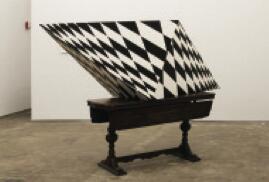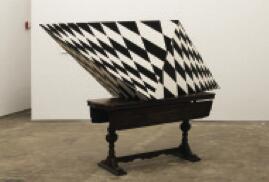The Every Other Dayi
Ideobox Art Space, Miam
The Every other Day, an exhibition that occupies the spatious first floor of the building adjoining the main exhibition premises of Ideobox Art Space, includes the recent work of eleven artists, the great majority of whom are currently based in New York City and have displayed an intense creative activity in the course of the presnt decade. They are Carol Bove, Ernesto Burgos, Beth Campbell, Michael DeLucia, Andrés Ferrandis, Jonah Groeneboer, Charles Harlan, Tim Hyde, Zak Kitnick, Ian Pedigo and Heather Rowe.

The idiomatic expression that provides the title to the show functions as a metaphor for the subversions within the sphere of the everyday and the displacements outside of this sphere that people’s usual actions undergo “the fabric of the familiar” as a result of the innumerable and constant transformations to which they are subjected in everyday life practices. Or, as the historian and philosopher Michel de Certeau suggests in his book L’invention du quotidien, as a result of the adaptations of the dominant cultural economy to comply with individual interests and rules. Based on this criterion, every artistic pro- posal selected by the curator Donald Johnson Montenegro for The Every Other Day takes upon itself a double responsibility: that of becoming involved with the usual and ordinary with the common, while simultaneously reconsidering it through strategies of interruption and disruption.
Johnson Montenegro has conducted his selection within a well- defined territory that enjoys a consolidated institutional recognition as contemporary artistic practice, and that incorporates the duchampian legacy of the ready made, the trail of refinement of modern constructivist art, the functioning of architecture within the visual arts as a tool for artistic reflection and production, the coexistence of state of the art materials and more traditional ones, including waste materials, and the post minimalist tendency to contaminate the investigation of form through politics. Carol Bove, Ian Pedigo and Andrés Ferrandis’s installations are comprised of a repertory of dissimilar objects and forms which apparently have no connectionmutual strangeness the viewer must confront. The referential shifts between sculpture and architecture that may be found in the works of Beth Campbell, Tim Hyde and Heather Rowe are oriented towards the exploration of the relationships and negotiations between subject, construction and space. The ambiguity in the material construction, perception and function of individual objects informs the searches of Michael DeLucia, Charles Harlan and Zak Kitnick; while Ernesto Burgos and Johan Goeneboer create a workfield with the legacy of modern art to reexamine the structural forms developed within it, its connections with present day life and the possibilities to dissolve its dichotomies.
Efficiently staged, The Every Other Day’s display and potential for interpretation complies with the curatorial approach. It also propitiates among the works exhibited a dialogical relationship open to the construction of new meanings.





